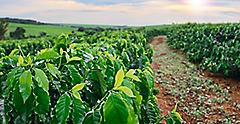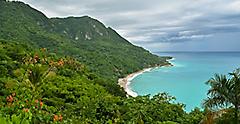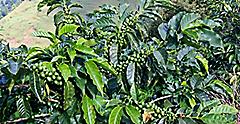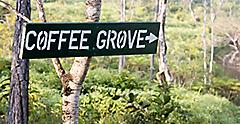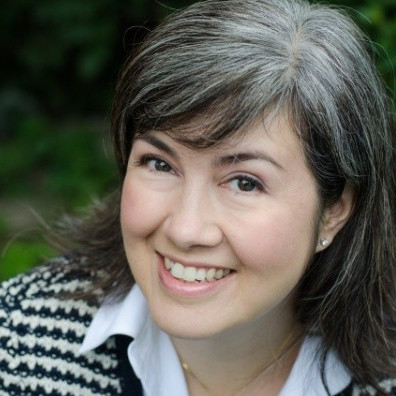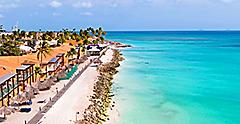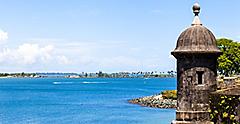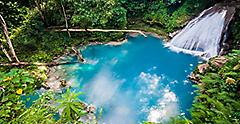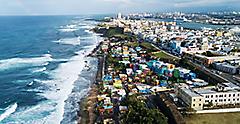How did each become so popular? Take a deep dive into the world of coffee traders and sugarcane farms and learn how each became an important part of the Caribbean's economy.
The Origins Of Coffee And Sugar
C offee and sugar have been companions for as long as most can remember. Coffee grows best along an equatorial zone called "The Bean Belt," located between latitudes 25 degrees North and 30 degrees South, and those tropics provide constant moisture and warm temperatures, allowing these crops to thrive. While sugarcane grows in a wider variety of regions, it flourishes in the tropics as well.
It's said that coffee originated in Africa, with the bean itself coming from in and around Ethiopia, while the first coffee drinkers date back to 15th-century Yemen, where they called it qahwah. According to PBS, legend has it that a young goat herder named Kaldi noticed his goats were even more energetic after eating some of these berries. He told his elders about it and they proceeded to try this bean so they could stay alert during their long prayers.
Coffee's Voyage
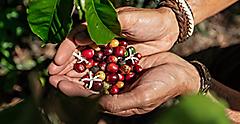
Coffee made its way to Europe and then eventually to the Caribbean in the 1700s via Gabriel de Clieu, according to Modern Farmer. De Clieu was a French naval officer and governor of Martinique, and he was so devoted to his task of delivering two coffee plants from Europe that he rationed his water to keep the plants alive.
From there, the coffee plants made their way to Saint-Domingue (present-day Haiti) and eventually spread across much of the Caribbean, Mexico and tropical South America, where they've been grown ever since.
As Europe's thirst for coffee grew, many of the European colonizers began importing African slaves in order to create a profitable trade.
By the late 1700s, Saint Domingue (French-occupied Haiti) was producing more than half of the entire world's coffee, though this began to decline in the 1800s following Napoleon's unsuccessful bid to regain control of the island via a reversal of the abolition of slavery, which resulted in Haiti's victory over the French troops and subsequent declaration of independence.

Sugar, Sugar
Coffee's partner-in-crime has a much longer history, with the first domesticated sugarcane plants dating back to around the eighth century BC in New Guinea. From there, the plant spread to Southeast Asia and eventually made its way to Europe. Although the Europeans tried to make the sugarcane a successful crop in Europe's southernmost regions, the temperature wasn't consistently warm enough to make plantations viable. The New World offered a much more promising environment, and a large-scale industry blossomed in the Caribbean, among other areas.
Spain and Portugal soon began reaping the financial rewards associated with the sugar trade, and as a result, most Caribbean islands were covered in sugarcane fields. The task of providing up to 90% of Europe's sugar was not an easy one, and initially, enslaved Africans formed the major part of the work force during the 1800s, prior to the abolition of slavery.
Here are the Caribbean islands that currently grow coffee beans and sugarcane in case you're looking for a delicious cup of coffee when you take your next trip.
Haiti
Haiti's farming model is somewhat influenced by the country's abolition of slavery and the subsequent division of farming plots to emancipated slaves that occurred. This assignment of plots meant that most Haitian peasants became part of the farming economy, often growing coffee in addition to other crops. Also involved in the distribution of sugar and coffee on Haiti was the curiously-named group of the Madame Saras, which were named after the migratory birds that gather in the treetops and chatter loudly. This group of women played a crucial role in moving goods from supplier to consumer in this largely informal economy.
Various factors, including a lack of infrastructure and competing crops, resulted in both cash crops petering out to virtually nothing in today's Haiti. There is hope for a coffee future there, though. A trio of intrepid Canadians attempted to source some of Haiti's last remaining heirloom coffee beans and founded a cooperative deep in the mountains of southern Haiti. Café Xaragua has worked with local growers to supply fair trade coffee to the North American market and sought to restore Haiti's depleted forests by replanting a coffee tree for every bag of coffee sold. Patrons can purchase coffee and even follow the progress of their tree online as they sip their cup of joe that helped bring the seed to life.
Dominican Republic
Unlike Haiti, the Dominican Republic's coffee industry is alive and well, though it doesn't contribute substantially to world production levels. Such is the strength of the coffee culture here that only about 20% of the beans make it off the island, according to The Coffee Hunters, with a per capita average of almost seven pounds consumed locally on an annual basis. This island is abuzz with caffeine!
There are six major coffee-growing regions: Cibao, Bani, Azua, Ocoa, Barahona and Juncalito. Most of them are in the mountainous areas and all display their own unique flavor profiles. High-altitude Barahona produces coffee that's coveted for its high acidity and denser body, resulting in an ultimately richer flavor. If it's mellower coffee you are after, then focus on Bani and Ocoa, while those in search of low-acid coffee should look for coffee that was grown in the Cibao region. Coffee plantations tend to be small, and much of the coffee grown here is organic.
Visiting a coffee plantation is best done through one of the many tour operators that are based in beach hot spots like Punta Cana and Puerto Plata. The operators are well-versed in both the best locations to visit as well as local roads, which can be challenging at times. Santo Domingo is the essential Dominican coffee to look out for and the largest operation as well, though it's fairly easy to buy in North America. Beyond this brand, there are numerous smaller labels offering high-quality options that may not be available in North America and can serve as a welcome reminder of the warm winds and sunny beaches of your vacation.
The history of sugarcane plantations here follows a similar trajectory as that of coffee in the region, having been introduced by the Spanish in the 16th century. Since then, the industry has become one of the major contributors to the country's agricultural exports, much of which are destined for the U.S. One ongoing challenge with the sugar industry in the Dominican Republic centers around the use of cheap Haitian labor to maintain lower costs. Even though laws were updated to implement basic labor standards and provide undocumented workers with paperwork, the situation in the fields has not improved significantly.
If you want to see a sugar plantation firsthand, there are a number of tours available, usually paired with cigars or rum (or both). Tour operators can easily be found in and around the La Romana Cruise Terminal. The availability of sugar has, of course, also resulted in a very successful rum industry. Notable industry leaders include Brugal near Puerto Plata, Ron Barcelo and possibly the most famous family name in the business, Bermudez.
Jamaica
The Jamaican sugar industry has been in existence for almost 500 years, and though it was initially introduced by the Spanish, it only really took off under British rule. While it relied on slavery in the early days, the Jamaican sugar industry has in the last century shifted its focus from labor-intensive activities to modern production means. Today, there are thousands of independent cane farmers responsible for the majority of the sugar production, and visitors to Jamaica can see some splendid estates, including Appleton Estates, purveyors of some of the globe's finest rum, and Worthy Park Estates, where the tour includes a virtual view of their sugarcane fields as well as bottling and sampling opportunities.
While the low-lying coastal areas may belong to beaches and sugarcane, the higher-altitude hills and mountains are the home of coffee, specifically the famous Blue Mountain Coffee. The coffee arrived on the island in the 18th century, later than sugarcane. A single plant from Martinique gave rise to a plantation and Jamaica's first coffee exports just nine years later. The rich volcanic soil of the Blue Mountains north of Kingston as well as the constant rain and clouds of the region result in some of the best low-acid coffee on the planet.
This coffee is so special that there are restrictions on where it may be grown, much like champagne. Beans can only originate from plants in one of four parishes on the island: Portland, St Andrew, St. Mary and St Thomas. It can be grown at heights of up to 6,000 feet (1.83 km).
The area in which the coffee is grown is fairly small, and production is limited. The prices are correspondingly high because of these factors and the fact that up to 80% of the coffee is destined for the Japanese market. Beware the many cheaper options available, some called Blue Mountain-style coffee. You get what you pay for!
There are a number of coffee producers who offer tours of their estates as well as many great options for lunches nearby and, of course, opportunities to sample this rare coffee.
The Best Of The Rest
In Belize, coffee growers have taken a unique approach to growing their coffee plantations and reducing the amount of deforestation. The Gallon Jug Coffee Estate is situated deep inside the Mayan rainforest, and their coffee is grown in the shade of giant mahogany trees, which gives the coffee plants the shelter and protection they need to flourish due to the lack of elevational cooling. It's a win for economy and ecology!
St. Lucia also has an interesting coffee history. The industry was almost extinguished entirely due to a number of wars between English and French colonial armies, but in the late 1970s, a private company got the industry going again, growing plants and then roasting and processing them using traditional methods. The resulting Green Gold mountain coffee is now a growing export and available for online purchase in North America.
Puerto Rico initially established their coffee industry under Spanish colonial rule, though the size of the industry dwindled post-annexation by the USA in 1898. It isn't until recently that the traditional haciendas have started reopening in and around the mountains that grow high-quality coffee in the volcanic soil. A selection of haciendas are accepting visitors (and no doubt offering pocillo, or espresso-style coffee).
There's terrific coffee to be sipped and savored all over the Caribbean. Add a pinch of tropical cane sugar if you like it sweet, and you'll have a cup of coffee to remember.
Get Royal Deals, Sign Up Today

Getting There
Best Deals to The Caribbean
Learn more about the history behind your cup of joe.

